Zhi-Xin Yang
Linearly Solving Robust Rotation Estimation
Jun 13, 2025Abstract:Rotation estimation plays a fundamental role in computer vision and robot tasks, and extremely robust rotation estimation is significantly useful for safety-critical applications. Typically, estimating a rotation is considered a non-linear and non-convex optimization problem that requires careful design. However, in this paper, we provide some new perspectives that solving a rotation estimation problem can be reformulated as solving a linear model fitting problem without dropping any constraints and without introducing any singularities. In addition, we explore the dual structure of a rotation motion, revealing that it can be represented as a great circle on a quaternion sphere surface. Accordingly, we propose an easily understandable voting-based method to solve rotation estimation. The proposed method exhibits exceptional robustness to noise and outliers and can be computed in parallel with graphics processing units (GPUs) effortlessly. Particularly, leveraging the power of GPUs, the proposed method can obtain a satisfactory rotation solution for large-scale($10^6$) and severely corrupted (99$\%$ outlier ratio) rotation estimation problems under 0.5 seconds. Furthermore, to validate our theoretical framework and demonstrate the superiority of our proposed method, we conduct controlled experiments and real-world dataset experiments. These experiments provide compelling evidence supporting the effectiveness and robustness of our approach in solving rotation estimation problems.
Accelerating Outlier-robust Rotation Estimation by Stereographic Projection
Feb 10, 2025Abstract:Rotation estimation plays a fundamental role in many computer vision and robot tasks. However, efficiently estimating rotation in large inputs containing numerous outliers (i.e., mismatches) and noise is a recognized challenge. Many robust rotation estimation methods have been designed to address this challenge. Unfortunately, existing methods are often inapplicable due to their long computation time and the risk of local optima. In this paper, we propose an efficient and robust rotation estimation method. Specifically, our method first investigates geometric constraints involving only the rotation axis. Then, it uses stereographic projection and spatial voting techniques to identify the rotation axis and angle. Furthermore, our method efficiently obtains the optimal rotation estimation and can estimate multiple rotations simultaneously. To verify the feasibility of our method, we conduct comparative experiments using both synthetic and real-world data. The results show that, with GPU assistance, our method can solve large-scale ($10^6$ points) and severely corrupted (90\% outlier rate) rotation estimation problems within 0.07 seconds, with an angular error of only 0.01 degrees, which is superior to existing methods in terms of accuracy and efficiency.
TiGDistill-BEV: Multi-view BEV 3D Object Detection via Target Inner-Geometry Learning Distillation
Dec 30, 2024



Abstract:Accurate multi-view 3D object detection is essential for applications such as autonomous driving. Researchers have consistently aimed to leverage LiDAR's precise spatial information to enhance camera-based detectors through methods like depth supervision and bird-eye-view (BEV) feature distillation. However, existing approaches often face challenges due to the inherent differences between LiDAR and camera data representations. In this paper, we introduce the TiGDistill-BEV, a novel approach that effectively bridges this gap by leveraging the strengths of both sensors. Our method distills knowledge from diverse modalities(e.g., LiDAR) as the teacher model to a camera-based student detector, utilizing the Target Inner-Geometry learning scheme to enhance camera-based BEV detectors through both depth and BEV features by leveraging diverse modalities. Specially, we propose two key modules: an inner-depth supervision module to learn the low-level relative depth relations within objects which equips detectors with a deeper understanding of object-level spatial structures, and an inner-feature BEV distillation module to transfer high-level semantics of different key points within foreground targets. To further alleviate the domain gap, we incorporate both inter-channel and inter-keypoint distillation to model feature similarity. Extensive experiments on the nuScenes benchmark demonstrate that TiGDistill-BEV significantly boosts camera-based only detectors achieving a state-of-the-art with 62.8% NDS and surpassing previous methods by a significant margin. The codes is available at: https://github.com/Public-BOTs/TiGDistill-BEV.git.
Space-time Reinforcement Network for Video Object Segmentation
May 07, 2024Abstract:Recently, video object segmentation (VOS) networks typically use memory-based methods: for each query frame, the mask is predicted by space-time matching to memory frames. Despite these methods having superior performance, they suffer from two issues: 1) Challenging data can destroy the space-time coherence between adjacent video frames. 2) Pixel-level matching will lead to undesired mismatching caused by the noises or distractors. To address the aforementioned issues, we first propose to generate an auxiliary frame between adjacent frames, serving as an implicit short-temporal reference for the query one. Next, we learn a prototype for each video object and prototype-level matching can be implemented between the query and memory. The experiment demonstrated that our network outperforms the state-of-the-art method on the DAVIS 2017, achieving a J&F score of 86.4%, and attains a competitive result 85.0% on YouTube VOS 2018. In addition, our network exhibits a high inference speed of 32+ FPS.
PU-EVA: An Edge Vector based Approximation Solution for Flexible-scale Point Cloud Upsampling
Apr 22, 2022


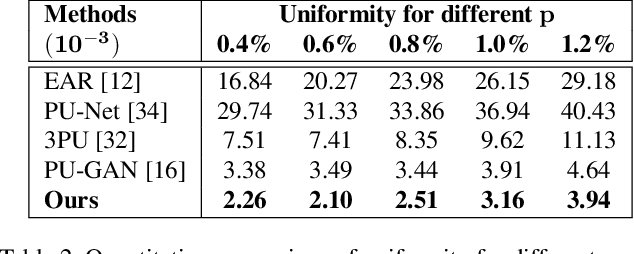
Abstract:High-quality point clouds have practical significance for point-based rendering, semantic understanding, and surface reconstruction. Upsampling sparse, noisy and nonuniform point clouds for a denser and more regular approximation of target objects is a desirable but challenging task. Most existing methods duplicate point features for upsampling, constraining the upsampling scales at a fixed rate. In this work, the flexible upsampling rates are achieved via edge vector based affine combinations, and a novel design of Edge Vector based Approximation for Flexible-scale Point clouds Upsampling (PU-EVA) is proposed. The edge vector based approximation encodes the neighboring connectivity via affine combinations based on edge vectors, and restricts the approximation error within the second-order term of Taylor's Expansion. The EVA upsampling decouples the upsampling scales with network architecture, achieving the flexible upsampling rates in one-time training. Qualitative and quantitative evaluations demonstrate that the proposed PU-EVA outperforms the state-of-the-art in terms of proximity-to-surface, distribution uniformity, and geometric details preservation.
Jacobian-based learning for inverse kinematics of soft robots
Dec 27, 2020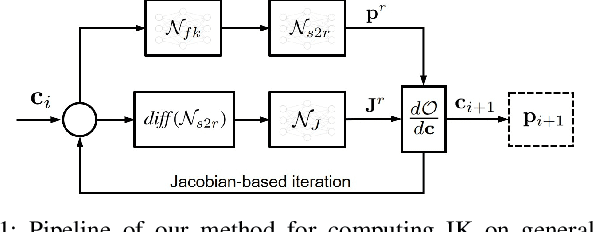
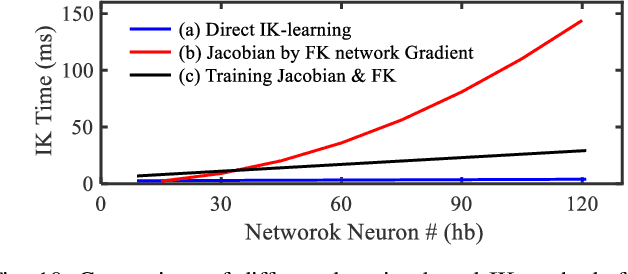
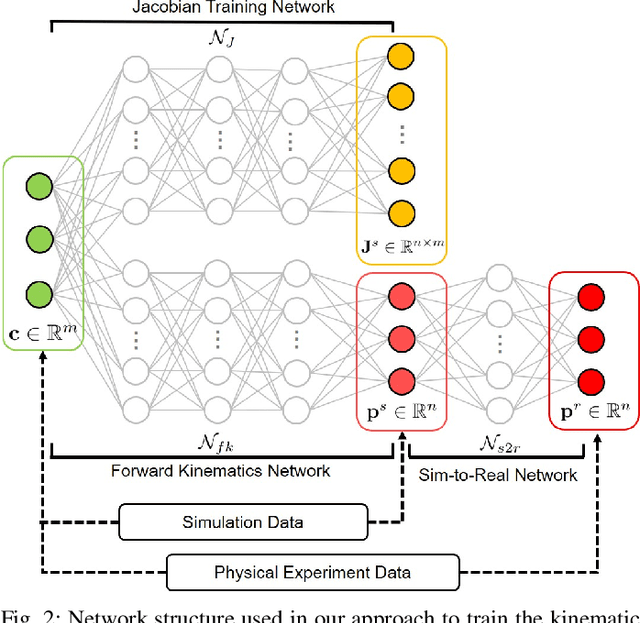
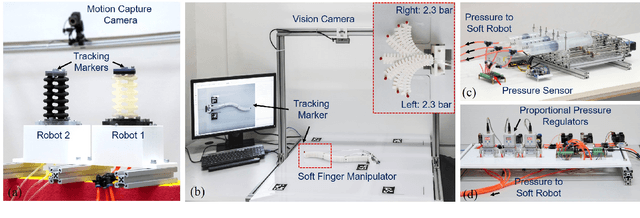
Abstract:This paper presents a new method to solve the inverse kinematic (IK) problem in real-time on soft robots with highly non-linear deformation. The major challenge of efficiently computing IK for such robots is caused by the lack of analytical formulation for either forward or inverse kinematics. To tackle this challenge, we employ neural-networks to learn both the mapping function of forward kinematics and also the Jacobian of this function. As a result, Jacobian-based iteration can be applied to solve the IK problem. A sim-to-real training transfer strategy is conducted to make this approach more practical. We first generate large amount of samples in a simulation environment for learning both the kinematic and the Jacobian networks of a soft robot design. After that, a sim-to-real layer of differentiable neurons is employed to map the results of simulation to the physical hardware, where this sim-to-real layer can be learned from very limited number of training samples generated on the hardware. The effectiveness of our approach has been verified on several pneumatic-driven soft robots in the tasks of trajectory following and interactive positioning.
Prognostics Estimations with Dynamic States
Sep 23, 2018
Abstract:The health state assessment and remaining useful life (RUL) estimation play very important roles in prognostics and health management (PHM), owing to their abilities to reduce the maintenance and improve the safety of machines or equipment. However, they generally suffer from this problem of lacking prior knowledge to pre-define the exact failure thresholds for a machinery operating in a dynamic environment with a high level of uncertainty. In this case, dynamic thresholds depicted by the discrete states is a very attractive way to estimate the RUL of a dynamic machinery. Currently, there are only very few works considering the dynamic thresholds, and these studies adopted different algorithms to determine the discrete states and predict the continuous states separately, which largely increases the complexity of the learning process. In this paper, we propose a novel prognostics approach for RUL estimation of aero-engines with self-joint prediction of continuous and discrete states, wherein the prediction of continuous and discrete states are conducted simultaneously and dynamically within one learning framework.
Robust Matrix Elastic Net based Canonical Correlation Analysis: An Effective Algorithm for Multi-View Unsupervised Learning
Nov 15, 2017



Abstract:This paper presents a robust matrix elastic net based canonical correlation analysis (RMEN-CCA) for multiple view unsupervised learning problems, which emphasizes the combination of CCA and the robust matrix elastic net (RMEN) used as coupled feature selection. The RMEN-CCA leverages the strength of the RMEN to distill naturally meaningful features without any prior assumption and to measure effectively correlations between different 'views'. We can further employ directly the kernel trick to extend the RMEN-CCA to the kernel scenario with theoretical guarantees, which takes advantage of the kernel trick for highly complicated nonlinear feature learning. Rather than simply incorporating existing regularization minimization terms into CCA, this paper provides a new learning paradigm for CCA and is the first to derive a coupled feature selection based CCA algorithm that guarantees convergence. More significantly, for CCA, the newly-derived RMEN-CCA bridges the gap between measurement of relevance and coupled feature selection. Moreover, it is nontrivial to tackle directly the RMEN-CCA by previous optimization approaches derived from its sophisticated model architecture. Therefore, this paper further offers a bridge between a new optimization problem and an existing efficient iterative approach. As a consequence, the RMEN-CCA can overcome the limitation of CCA and address large-scale and streaming data problems. Experimental results on four popular competing datasets illustrate that the RMEN-CCA performs more effectively and efficiently than do state-of-the-art approaches.
 Add to Chrome
Add to Chrome Add to Firefox
Add to Firefox Add to Edge
Add to Edge